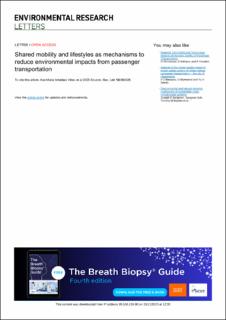| dc.contributor.author | Arbeláez Vélez, Ana María | |
| dc.contributor.author | Ivanova, Diana | |
| dc.contributor.author | Stadler, Konstantin | |
| dc.date.accessioned | 2023-11-16T07:24:28Z | |
| dc.date.available | 2023-11-16T07:24:28Z | |
| dc.date.created | 2023-08-22T12:49:21Z | |
| dc.date.issued | 2023 | |
| dc.identifier.issn | 1748-9326 | |
| dc.identifier.uri | https://hdl.handle.net/11250/3102871 | |
| dc.description.abstract | Despite the deployment of low- or zero-emission technologies, achieving emissions reductions in the passenger transportation sector remains challenging. Demand-side mechanisms can be instrumental in reducing environmental impacts of transportation and reconfiguring transportation systems in a way that shifts users away from private car ownership. In this article we look at the Netherlands, Sweden, and the United States to quantify the environmental benefits from such shifts in passenger transportation, considering socio-technological drivers of transportation including well-being, digitalization, shared mobility, and electrification. We establish pathways for each of these countries considering their context. We frame these pathways using the avoid-shift-improve framework which shapes the scenarios that we quantify in our analysis. We use a travel demand model as an input to calculate carbon, energy, and air pollution footprints. We quantify direct emissions considering the characteristics of the private fleet and indirect using multiregional input-output analysis. The results show that target thresholds can be reached under the proposed supply and demand initiatives. For the United States, these actions are more dramatic than for the Netherlands and Sweden due to that country's stronger car dependence. A deep social transformation is needed to make these scenarios possible and enable a shift towards public, active and shared transportation in urban areas. | en_US |
| dc.language.iso | eng | en_US |
| dc.publisher | IOP Publishing | en_US |
| dc.rights | Navngivelse 4.0 Internasjonal | * |
| dc.rights.uri | http://creativecommons.org/licenses/by/4.0/deed.no | * |
| dc.title | Shared mobility and lifestyles as mechanisms to reduce environmental impacts from passenger transportation | en_US |
| dc.title.alternative | Shared mobility and lifestyles as mechanisms to reduce environmental impacts from passenger transportation | en_US |
| dc.type | Peer reviewed | en_US |
| dc.type | Journal article | en_US |
| dc.description.version | publishedVersion | en_US |
| dc.source.volume | 18 | en_US |
| dc.source.journal | Environmental Research Letters | en_US |
| dc.source.issue | 8 | en_US |
| dc.identifier.doi | 10.1088/1748-9326/ace465 | |
| dc.identifier.cristin | 2168726 | |
| cristin.ispublished | true | |
| cristin.fulltext | original | |
| cristin.qualitycode | 2 | |

